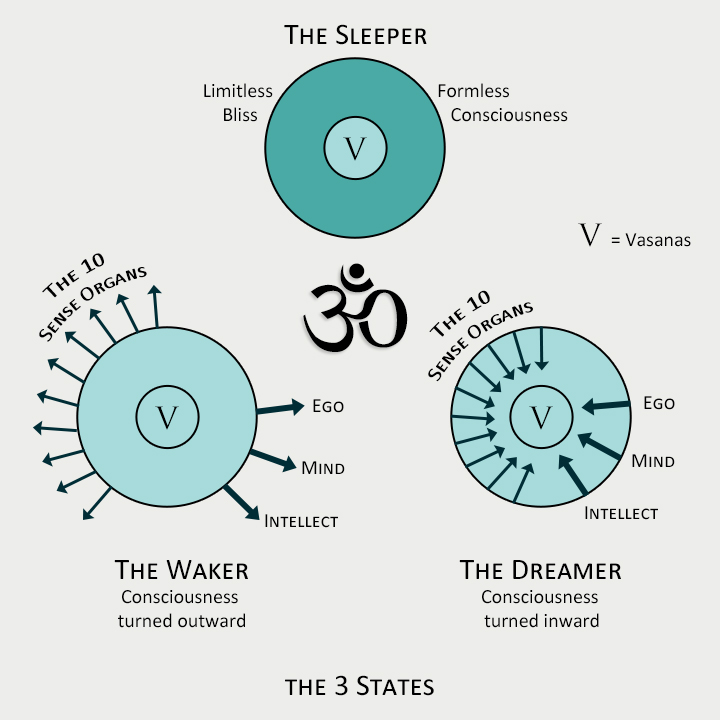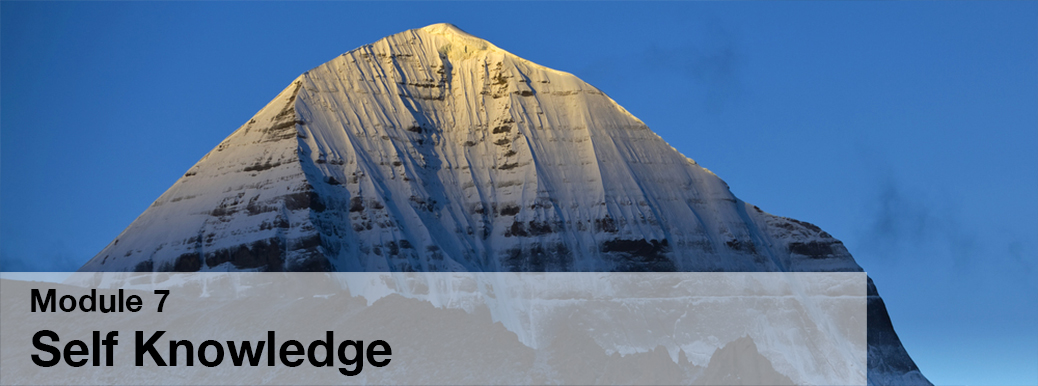Introduction
The 3 states (Avastha Trayam) teaching of Vedanta is a sophisticated discrimination involving the analysis of the 3 states of experience and their experiencing entities.
We will look into these 3 states in detail and also explain why this teaching is an important part of Self-inquiry.
This teaching comes from the Mandukya Upanishad. Mandukya means a frog. So the literal translation is the “Frog Upanishad”. The 3 states are compared to lily pads, and the Jiva (individual) to a frog. Just as a frog jumps from one lily pad to another, a Jiva jumps from one state to another.
While studying the 3 states we will look at 3 factors associated with each state. This will help us understand these vastly different states of experience based on a common criterion.
The 3 factors are:
- The condition of the mind in each state, as the mind plays a prominent role in each state.
- The nature of experience in each state.
- The dominant medium in each state.
I. The Waking State of Experience
This “I” is called the Waking state ego or Viswa in Sanskrit.
The waking state entity is consciousness turned outward, shining through the senses, mind and intellect.
The waking state entity is a consumer of experience. Self Inquiry calls it “the one with thirteen mouths”. The thirteen mouths refer to the ten senses, the mind, intellect and the ego.
These instruments aggressively eat experience. The physical body consumes matter, the mind consumes emotions, the intellect consumes ideas, and the ego eats any experience it believes will make it happy.
1. Condition of the Mind
2. Nature of Experience
b. It is a tangible world available to other people as well.
c. In a way we can say that it is an objective experience because the objects we experience are also available to others.
d. The waking state world is experienced via the 5 sense instruments of knowledge in the Subtle Body – eyes, ears, nose, tongue & skin.
e. The waking state experience is a 2-way transaction. I receive experience from the world, and I also respond to the world. I am a doer, and also an enjoyer.
3. Medium of Experience
For e.g. the eye sense requires the physical eyes and the ear sense requires the physical ears. Therefore the sense organs require the physical body for their functioning.
Because I have to experience the external world, I need sense organs; to operate sense organs, I need the body. So without the Gross Body, the physical world cannot be experienced. So the Gross Body can be said to be the dominant medium in the waking state.

II. Dream State
Like the waking state entity, the dreamer believes his of her world is real. Dreams appear in light, even though the waking senses are inactive, because Awareness shines through the dreamer, just as it shines through the waking state entity.
The dreamer is called Taijasa in Sanskrit.
1. Condition of the Mind
Not only physical events are recorded, but various emotions like happiness and sorrow are also recorded.
The emotions we experience in the dream state are not fresh emotions, but the replaying of the recorded emotions of waking state.
Everything that happens in a dream is only from our memories and Vasanas.
So in the dream state:
a. The emotional faculty does not register new emotions.
b. The intellect is dormant.
c. The Ego faculty does not function. Even the dream ego is from memory, and not a fresh ego.
Therefore the Subtle Body can be said to be only partially functioning in the dream state.
2. Nature of Experience
b. This internal world is constructed out of our memories and Vasanas. The external world is a concrete world, whereas the internal world is abstract, as it is made out of our thoughts.
c. The dream world is a subjective world, only available to me, not others.
d. The dream world is not perceived by sense organs. It is based on memories of waking state.
Doubt – Sometimes we experience objects in dream state which we have not experienced in waking state.
In such cases these might be one of the possible explanations:
a. New objects cannot be created in dream state, but it’s possible to combine various objects from waking state to create seemingly new objects. For e.g. a rabbit with a horn. Dream objects are thought based; thoughts are highly fluid; so dream objects are also highly fluid.
b. Out fantasies and imaginations from waking state can sometimes be given shape in the dream world.
c. Memory belongs to Subtle Body. The Subtle Body continues from one life to another. So it’s possible in rare cases for dreams to be based on memories of past lives.
d. In even rarer cases some people claim to see future events in dreams. You cannot say such dreams are memory based, since the event has not yet happened. So it is not a dream created out of a memory or Vasanas.
Any future event always exists in potential form in the Macrocosmic Causal Body (Isvara). If a mind is sensitized enough, it is possible for it to peek into future events. So it is not a dream but an unique faculty of the mind which some Yogis try to develop. So such ESP experiences, though rare, are possible.
3. Medium of Experience

III. Sleep State
Deep sleep is defined as a state, filled with happiness, where there is no external or internal world. In the other states, consciousness flows either inwards or outwards, but in sleep it is formless.
The sleeper ego is extremely subtle, its presence indicated by the fact that we experience limitlessness and bliss. In the waking and dream state, bliss is sporadic because it is broken by many changes in thoughts and feelings, but in sleep it is continuous.
We know of the sleeper’s experience because it reports a good sleep after transforming into a waking state entity. If the waking state entity was actually a different ego from the sleeper or the dreamer, then it would not recall the experience of sleep or dream. In reality both are just consciousness.
The sleeper is called Prajna in Sanskrit.
1. Condition of the Mind
There are no emotions in sleep state because the emotional faculty is not working; since intellect is not functioning there is no knowledge; no memory takes place because there is no memory faculty; and since there is no Ego, even the sense of “I am sleeping” is not there.
The Subtle Body is “as though” resolved into the Causal Body. The phrase “as though” is important, because the extremely subtle sleeper ego – Prajna – does exist in deep sleep. So we cannot say that the Subtle Body is completely resolved into the Causal Body.
The Sleep state is also referred to as a seed state. When the seed sprouts, the sleeper becomes a waking state entity or a dreamer and experiences the appropriate world.
2. Nature of Experience
Therefore sleep is a state of total self-ignorance.
3. Medium of Experience
So the Causal Body is the medium of experience in the sleep state.

The 3 States and Self Inquiry

Now we will look into why the study of the 3 states is important for Self Inquiry.
Because of its association with one of the 3 states of experience, the Self appears to be 3 distinct entities.
Associated with the waking state, it “becomes” a waking state personality, suffering and enjoying the limitations of the world. The dreamer suffers the limitations of the dream world. And the sleeper experiences limitless bliss but remains self-ignorant.
Who Am I?
I surrender everything essential to my idea of myself (my body, mind, intellect, and all my physical possessions) and get into a state of total self-ignorance.
Yet in spite of the pleasure of sleep, I am not content because I sacrifice my sleep identity to suffer and enjoy the worlds created by my Vasanas in waking and dream states.
My identity as a dreamer is obviously unsatisfactory because I consistently leave it to become a sleeper or a waker.
So my status as any ego is limited, and my true identity is open to question.
The answer to “Who am I” is: I am not any of these ego entities. If I am real, I have to exist all the time. I cannot suddenly be one thing one minute and something else the next.
In fact, the waker, dreamer and sleeper are all non-dual Awareness identified with the particular state they are experiencing. Awareness is the witness of the 3 states.
Ignorance operates in the dream and waking states, causing the Self to identify with the dream and waking egos and their doings, preventing the realization of its true identity as me, the Self.
In deep sleep the ego is “as though” dissolved into the Causal Body. It is not aware of the Self or anything external. Yet Awareness is there, making the experience of bliss possible.
And when we wake up we know that we slept, even though we were not there as the waking state entity, because Awareness was there.
In the wake of this understanding, I am free to assume my true identity as Awareness, because it is the only other option. Awareness cannot be denied or negated.
The Substrate
The substrate is another name for the Self, because the Self pervades everything.
It is very easy to identify with the body-mind complex and take it up as our real identity because Awareness cannot be perceived by the senses or the mind.
When I inquire into this substrate, I find that I am whole and complete. I see that nothing is missing. Because nothing is missing, I am free of desire, and because I am free of desire, I am peaceful. I see that I never change.
Summary
| 1. | In their daily life an individual goes through 3 different states of experience – the waking, dream and sleep state. The waking state entity (Viswa) is a consumer of worldly experience. The Viswa’s Subtle Body is fully operational, and it interacts with an external, tangible world via the medium of sense organs. |
| 2. | The dream entity’s (Taijasa) Subtle Body is partly functional. The Taijasa interacts with an internal, subjective world, created out of its memories and Vasanas. |
| 3. | The deep sleeper’s (Prajna) Subtle Body is almost dormant, and it experiences limitlessness and bliss, while at the same time remaining self-ignorant. There is no external or internal world for the Prajna. |
| 4. | By analysing the 3 states, I come to the conclusion that I am neither the waker, dreamer or the sleeper. My real identity is the “I” that cannot be negated, the Self. Once this knowledge is firm and abiding, I am free. |


